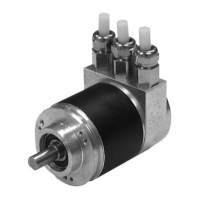Absolute rotary encoder P**58
Installation
Subject to reasonable modifications due to technical advances. Copyright Pepperl+Fuchs, Printed in Germany
Pepperl+Fuchs Group • Tel.: Germany +49 621 776-0 • USA +1 330 4253555 • Singapore +65 67799091 • Internet http://www.pepperl-fuchs.com
Date of issue 01/15/04
8
2.3 Wiring of connection hood
Proceed as follows in the wiring:
• Remove the pressure screw, pressure insert and cone from the cable gland.
• Remove about 55 mm of the bus line covering and about 50 mm of the screening
mesh.
• Remove about 5 mm of insulation on the individual wires.
• After that, push the pressure screw and pressure insert onto the cable.
• Push the cone under the screen as shown in the drawing.
• Push the pressure screw, pressure insert and cone into the cable gland.
• Then tighten the pressure screw.
2.4 Connecting the screen line
To achieve the best interference immunity possible, the transfer of signals between
the system components should be via shielded lines with a shield seating on either
side. With certain system configurations an equalisation current can flow through the
shield connected on both sides of the cables. Because of this, a potential equalisation
line is recommended.
2.5 Notes on mechanical fitting and the electrical connection
Please observe the following items:
Do not drop the rotary encoder or expose it to significant vibration. It is a precision
instrument.
Do not open the rotary encoder housing (this does not mean you should not remove
the hood). Opening or closing the device improperly may damage it or result in
contamination.
The rotary encoder shaft must be connected with the shaft to be measured by means
of a suitable coupling. The purpose of this coupling is to absorb blows and imbalances
and prevent major forces from reaching the rotary encoder shaft. Suitable couplings
are available from Pepperl+Fuchs.
Rotary encoders are sturdy, but they should be protected by suitable protective
measures when used in a very harsh environment. In particular, they should not be
fitted to make them suitable for holding grips or stepping blocks.
Commissioning and operation of this electrical device must only be performed by
qualified personnel. This means persons who are authorised to place devices,
systems and circuits in service, ground them and identify them with appropriate
markings according to the latest state of fail-safe technology.
No electrical changes must be made to the rotary encoder.

